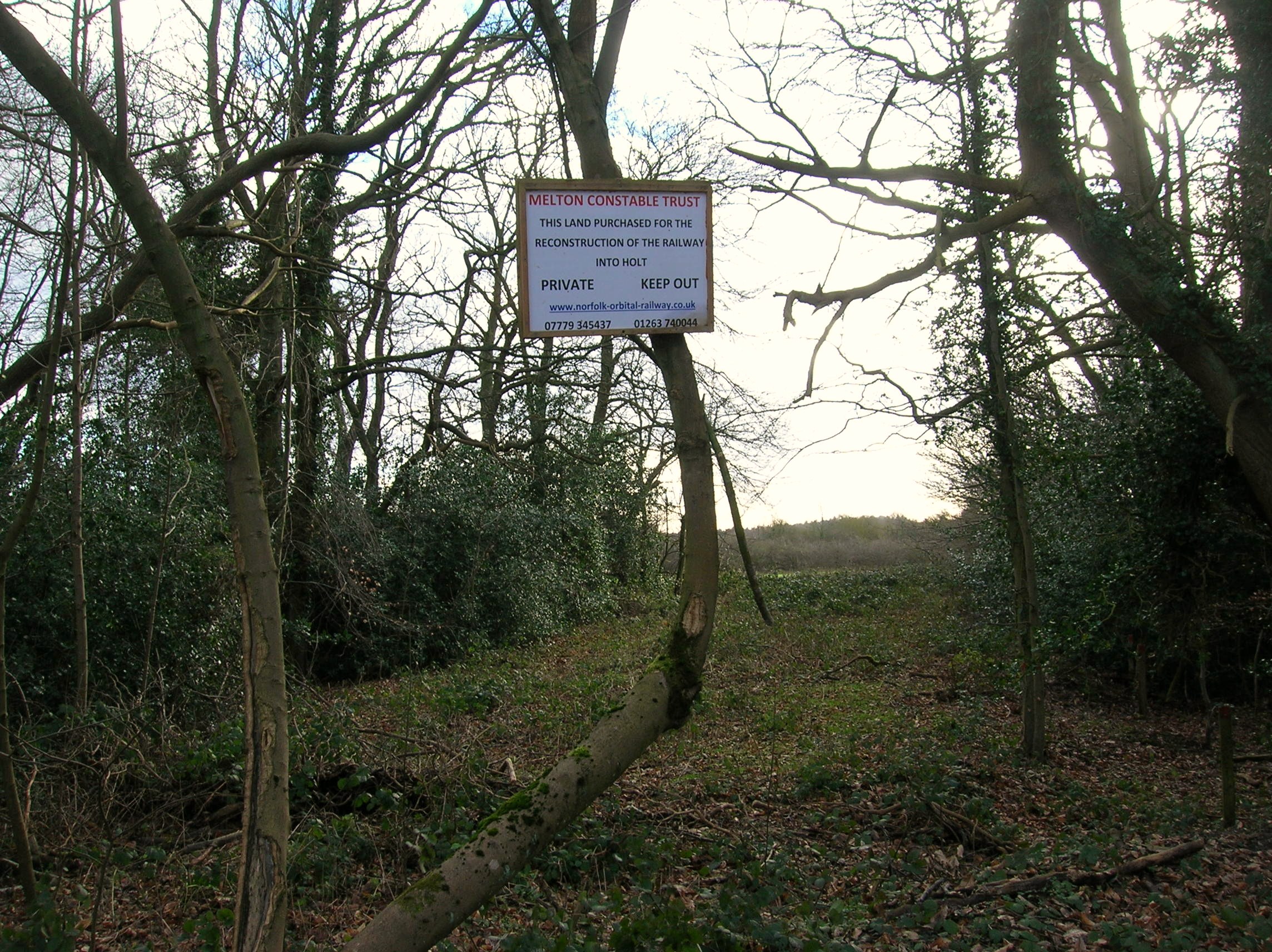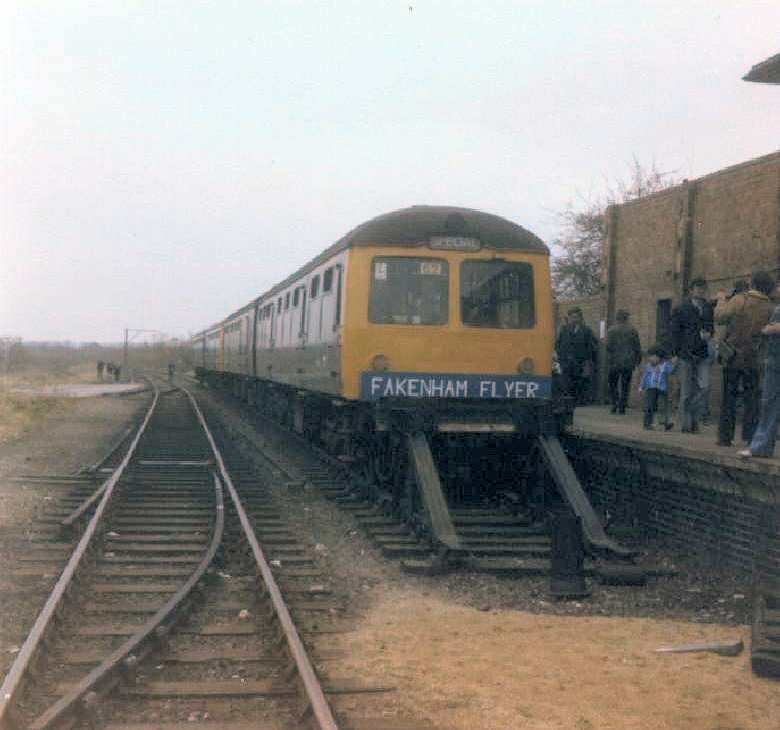|
Ryburgh Railway Station
Ryburgh railway station was a railway station in the village of Great Ryburgh in the English county of Norfolk. History The station opened in 1857, when the line between Dereham and Wells opened as part of the Norfolk Railway. The entire line, between Wymondham and Wells, became part of the Great Eastern Railway in 1862. The passenger service between Dereham and Wells ended on 5 October 1964, Tuddenham, 1965, page 87 although the line remained open for goods trains as far as Fakenham. The closure of the station was discussed in the House of Lords on 22 June 1964, with Lord Wise asking Lord Chesham what the government intended to do to address the tonnage of grain that the closure would put onto local roads. 1978 saw the formation of the Fakenham and Dereham Railway Society, a forerunner of the Mid-Norfolk Railway, which hoped to preserve the line between these two towns. A charter train ran as far as Fakenham in 1979, but the section of line between Ryburgh and Fakenh ... [...More Info...] [...Related Items...] OR: [Wikipedia] [Google] [Baidu] |
Ryburgh Station 2009
Ryburgh is a civil parish in the English county of Norfolk. The parish is south-west of Cromer, north-west of Norwich and north-east of London. The parish lies south-east of the nearby town of Fakenham. The nearest railway station is at Sheringham for the Bittern Line which runs between Sheringham, Cromer and Norwich. The nearest airport is Norwich International Airport. The parish includes the villages of Great Ryburgh and Little Ryburgh. It covers an area of and had a population of 668 in 264 households at the 2001 census, the population increasing to 694 at the 2011 Census. For the purposes of local government, it falls within the district of North Norfolk. The parish has two main religious buildings: St. Andrew's a Church of England round-tower church and a small Methodist chapel. In addition to these there is St. Clare's chapel a small Roman Catholic Roman or Romans most often refers to: *Rome, the capital city of Italy *Ancient Rome, Roman civilization from 8th ce ... [...More Info...] [...Related Items...] OR: [Wikipedia] [Google] [Baidu] |
Norfolk Orbital Railway
The Norfolk Orbital Railway — as the Holt, Melton Constable and Fakenham Railway Company — is a proposed rail project in Norfolk, England, which is proposed to look at bringing a new rail connection to North and Mid Norfolk. The proposed line would link stations at Sheringham and Wymondham on the national rail network by using tracks of the two standard gauge heritage railways in the county, and restoring the former Midland and Great Northern Joint Railway line between Holt and Fakenham, creating a circular route that could be used by passenger services. The heritage lines affected are Mid-Norfolk Railway and the North Norfolk Railway, with the route including stations on both of these lines as well as on part of National Rail network and on a disused section between County School and Holt. These are both 2 entirely separate enterprises. History The line from Fakenham to Melton Constable was built by the Lynn and Fakenham Railway, later the Midland and Great Northern ... [...More Info...] [...Related Items...] OR: [Wikipedia] [Google] [Baidu] |
Railway Stations In Great Britain Closed In 1964
Rail transport (also known as train transport) is a means of transport that transfers passengers and goods on wheeled vehicles running on rails, which are incorporated in tracks. In contrast to road transport, where the vehicles run on a prepared flat surface, rail vehicles (rolling stock) are directionally guided by the tracks on which they run. Tracks usually consist of steel rails, installed on sleepers (ties) set in ballast, on which the rolling stock, usually fitted with metal wheels, moves. Other variations are also possible, such as "slab track", in which the rails are fastened to a concrete foundation resting on a prepared subsurface. Rolling stock in a rail transport system generally encounters lower frictional resistance than rubber-tyred road vehicles, so passenger and freight cars (carriages and wagons) can be coupled into longer trains. The operation is carried out by a railway company, providing transport between train stations or freight customer facilit ... [...More Info...] [...Related Items...] OR: [Wikipedia] [Google] [Baidu] |
Railway Stations In Great Britain Opened In 1857
Rail transport (also known as train transport) is a means of transport that transfers passengers and goods on wheeled vehicles running on rails, which are incorporated in Track (rail transport), tracks. In contrast to road transport, where the vehicles run on a prepared flat surface, rail vehicles (rolling stock) are directionally guided by the tracks on which they run. Tracks usually consist of steel rails, installed on Railroad tie, sleepers (ties) set in track ballast, ballast, on which the rolling stock, usually fitted with metal wheels, moves. Other variations are also possible, such as "slab track", in which the rails are fastened to a concrete foundation resting on a prepared subsurface. Rolling stock in a rail transport system generally encounters lower friction, frictional resistance than rubber-tyred road vehicles, so passenger and freight cars (carriages and wagons) can be coupled into longer trains. The rail transport operations, operation is carried out by a ... [...More Info...] [...Related Items...] OR: [Wikipedia] [Google] [Baidu] |
Former Great Eastern Railway Stations
A former is an object, such as a template, gauge or cutting die, which is used to form something such as a boat's hull. Typically, a former gives shape to a structure that may have complex curvature. A former may become an integral part of the finished structure, as in an aircraft fuselage, or it may be removable, being using in the construction process and then discarded or re-used. Aircraft formers Formers are used in the construction of aircraft fuselage, of which a typical fuselage has a series from the nose to the empennage, typically perpendicular to the longitudinal axis of the aircraft. The primary purpose of formers is to establish the shape of the fuselage and reduce the column length of stringers to prevent instability. Formers are typically attached to longerons, which support the skin of the aircraft. The "former-and-longeron" technique (also called stations and stringers) was adopted from boat construction, and was typical of light aircraft built until the ... [...More Info...] [...Related Items...] OR: [Wikipedia] [Google] [Baidu] |
List Of Closed Railway Stations In Norfolk
This is a list of closed railway stations in Norfolk, England. There are also a number of heritage railway stations in Norfolk Norfolk () is a ceremonial and non-metropolitan county in East Anglia in England. It borders Lincolnshire to the north-west, Cambridgeshire to the west and south-west, and Suffolk to the south. Its northern and eastern boundaries are the No ..., which have been re-opened by preservation societies. The companies listed are the pre-1923 groupings. Goods stations References {{Unreferenced, date=April 2008 See also * Railways in Norfolk Norfolk railway stations Rail transport in Norfolk Railway stations Norfolk ... [...More Info...] [...Related Items...] OR: [Wikipedia] [Google] [Baidu] |
Fakenham West Railway Station
Fakenham West railway station was a station in Norfolk. It was built as part of the Midland and Great Northern Joint Railway main line that meandered across Norfolk to Great Yarmouth. The station was opened by the Lynn and Fakenham Railway on 16 August 1880, when it was originally named ''Fakenham Town'', and was renamed ''Fakenham'' by 1910. Following railway nationalisation, it was renamed again to become ''Fakenham West'' by British Railways on 27 September 1948. The station was closed on 2 March 1959. Part of a platform from the station survives outside the car park of the Jewson builder's merchant, and the trackbed south of the platform is visible as a roadway. The town was served by two stations on separate lines. Fakenham East railway station was on the Great Eastern route between Wells-on-Sea and Wymondham. Currently there are no rail links to Fakenham; however, this may change in the future with the Norfolk Orbital Railway, which would use the proposed new-build sta ... [...More Info...] [...Related Items...] OR: [Wikipedia] [Google] [Baidu] |
County School Railway Station
''County School railway station'' is on the Mid-Norfolk Railway in Norfolk, England; it will serve the villages of North Elmham and Guist once services resume. It is 17 miles 40 chains (28 km) down the line from Wymondham and is the northernmost station owned by the Mid-Norfolk Railway Preservation Trust. The station is part of the Wymondham to Wells Branch, which closed to passengers in 1964, and is the western terminus of the East Norfolk Railway branch to Wroxham, which closed in 1952. The line from Dereham is being gradually restored by the Mid-Norfolk Railway. History Opening A railway line was opened as part of the Norfolk Railway's extension from East Dereham to Fakenham in 1849; it reached Wells by 1857. County School railway station was built by the Great Eastern Railway in 1886 to serve the boarding school from which it took its name and following the completion of the East Norfolk Railway's branch line from Wroxham and Aylsham in 1882. In 1903, the Norfolk Co ... [...More Info...] [...Related Items...] OR: [Wikipedia] [Google] [Baidu] |
Fakenham East Railway Station
Fakenham East railway station was a railway station in the market town of Fakenham in the English county of Norfolk. The station was opened by the Norfolk Railway on 20 March 1849 and was originally named ''Fakenham''. Following nationalisation, it was renamed ''Fakenham East'' by British Railways on 27 September 1948; it was closed on 5 October 1964. This station is one of the possible sites protected in local plans, if needed as part of the Norfolk Orbital Railway's long-term plans to return trains to Fakenham. Any replacement station would be built on the throat of the original site, as sheltered housing has been built on the main station site. Other developments north of the former station make further extension impractical; instead the 'Norfolk Orbital' scheme proposes reopening towards the North Norfolk line at Holt and the Mid-Norfolk line at County School. The railway formation south of the station, as far as the three-arch viaduct over the River Wensum, is now owned ... [...More Info...] [...Related Items...] OR: [Wikipedia] [Google] [Baidu] |
Fakenham
Fakenham is a market town and civil parish in Norfolk, England. It is situated on the River Wensum, about north west of Norwich. The town is the junction of several local roads, including the A148 from King's Lynn to Cromer, the A1067 to Norwich and the A1065 to Swaffham. The civil parish has an area of and in the 2001 census had a population of 7,357 in 3,292 households, the population increasing to 7,617 at the 2011 census. For the purposes of local government, the parish falls within the district of North Norfolk.Office for National Statistics & Norfolk County Council (2001). Census population and household counts for unparished urban areas and all parishes'. Retrieved 2 December 2005. Fakenham has been a market town since 1250, particularly known for its corn, barley and wheat trading, and in the 19th century it became noted for its printing. Fakenham Racecourse is a thoroughbred horse racing venue to the south of Fakenham. The town has a long name of Fakenham Lancaster ... [...More Info...] [...Related Items...] OR: [Wikipedia] [Google] [Baidu] |





